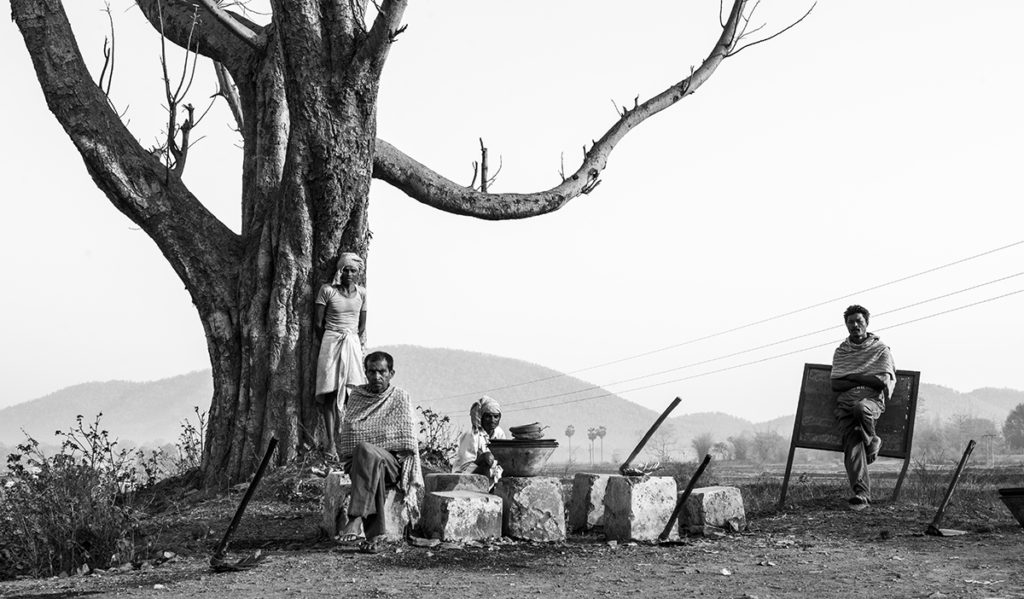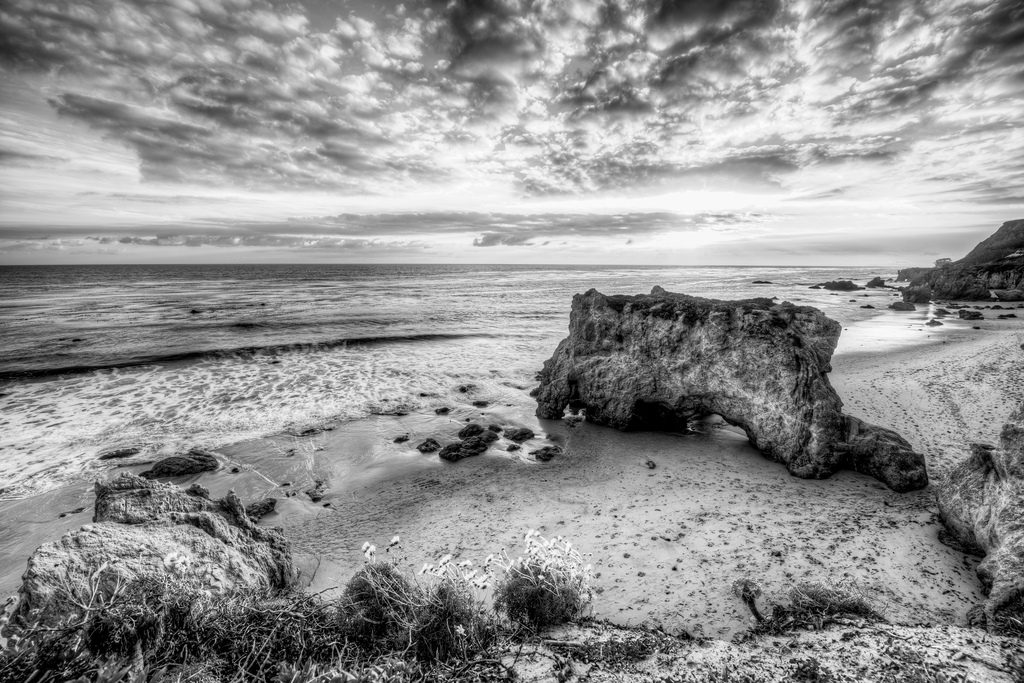Waiting for Work, Jharkhand, India, 2014. Prabuddha Ray
If you were to show me the photo above and ask me guess whether it was film or digital, my guess would be film. I’d say film because the sky is white. White skies, with little or no distinction between the sky and clouds, are a fairly reliable signature of traditional silver halide b&w photography. Panchromatic black-and-white film is more sensitive to blue than to other colors (although by how much varies with the emulsion, some being more sensitive to greens and others to reds than others. Orthochromatic b&w film is very sensitive to blue) and thus, film will overexpose blue skies relative to terrestrial subjects, giving you a white sky.
When shooting b&w film, if I want a detailed sky, I’ll use a K2 yellow or #25 “light red” filter. The principle is basic. A filter transmits light of its own color and absorbs its complementary color. It follows that the way to darken sky and make clouds stand out is to use a yellow or red filter, red being blue’s complimentary color. A yellow filter will render the sky more or less “normally” – i.e there’ll be a distinct tonality to the sky, lighter at the horizon and getting darker as you move up, clouds visible. The #25 light red will give you a darker sky and more dramatically contrasted clouds, more like what you’d expect with digital b&w. To get the full-on dawn-of-the-dead look, I’d use a #29 dark red filter.
*************
B&W Digital Skies. Nikon D800 (photographer unknown)
Above is an example of how a digital sensor renders sky. Digital sensors don’t have the same color biases as do film stocks. A digital sensor typically has equal Red, Green and Blue sensitivity, the result being photos that represent sky with much more detail than does film.
It’s that, along with its increased sharpness/acutance and less highlight roll off, which differentiates digital b&w from film b&w. While ‘film emulation’ software like Silver Efex helps narrow the aesthetic difference, no amount of running native digital files through emulation software will completely eradicate the differences inherent in the capture, and a trained eye can see the difference.
Of course, arguing the relative merits of either is a matter of taste. Each medium is a transcription and not an objective rendering. The reason I prefer the first photo to the second, apart from other subjective aesthetic issues, is because my photographic tastes were created and shaped during the film era and that look is the standard I use when judging digital b&w. It looks “natural” to me, the digital looking like an affectation. Someone coming of photographic age in the digital era might, and probably does, see things differently. That’s OK.
I do like Mr. Ray’s photo, for reasons over and above its ‘film look.’ Interesting then, that it’s not from a negative but was shot with a Nikon D800, proving that for every generalization there’s a thousand exceptions. What’s notable to me about the photo is that it hasn’t been self-consciously post-processed with all the usual b&w film clues – grain, specific tonal looks etc. It’s just the sky, or the lack of it, that drew my eye to it after googling “Nikon D800 B&W,” it being an outlier in a sea of overdone “zombie apocalypse” skies like the photo below. Something that simple.




I fell in love with photography the day a friend showed me his drugstore prints from a roll of Tri-X. They were amazing while still being just everyday snapshots of the most trivial of subjects. Within a few months, I owned two Nikons and had a black and white darkroom in my bathroom. That was 45 years ago and I’ve loved black and white photos ever since. Today, I have come to love the look of digital B&W. I love the way digital renders grey tones. The tones appear more balanced and detailed and even more natural, to my eyes anyway. It’s subjective, as you say in the article. I cannot argue digital over film or film over digital. I have more experience and a longer love affair with film but I’ve shot only digital for the last 10 years or so. Digital has a look that is quite beautiful on its own without trying to emulate film.
I confess, I am not that sophisticated. I cannot tell whether a photograph is digital or film. I know there are signposts, I just don’t know for sure what technology is behind an image, the more so as a film negative can be (usually is?) “translated” into a digital print.
For me it is all about process, not result. That is to say, the act of taking the picture is integral to the result, if not for the viewer, then to the photographer, or I should say, to this photographer. Garry Winogrand carried this attitude to the extreme, leaving behind several thousand rolls of undeveloped film and three times that developed but never contact printed, let alone realized. As said, it is extreme, but for GW it was about seeing and pushing the shutter release– the act of capturing. I suppose the logic would lead him to prefer digital as it is pain free mass shooting, but I am not going to let logic interfere here.
Digital offends, not because the result is inferior but because the process is inferior. It leads, I believe, to mindless snapping because there is no cost. Not in time, not in money, not in thinking. Instant and painless, it rewards volume.
In this connection, using filters to achieve a visualized effect represents real effort. Even the word “wratten” is evocative of alchemy, something to be studied and mastered. Digital post-processing, not so much. It is correctly termed “manipulation,” and that reflexively leads to antennae up and at attention. Is pre- better than post-?
Cartier famously delegated processing to others, concentrating on getting the image. His prints are deliberately bland, the better to point up the geometry of the scene– in some ways the antithesis of Ansel Adams and his drama drenched images.
With digital we enter a brave new world; perhaps my age is showing. Would Adams, Cartier, Winogrand use digital? Does it matter?
It’s a funny thing, but photography, for me, became ever more to mean little beyond the final result.
Was a time that cameras came with their own buzz, and yes, different formats forced one to work in different modes or styles, but that was really to do with how the final picture was going to be used. If I had to pick between the Nikons and the 500 Series ‘blads, I’d say the Nikons for speed and probably better captures of facial expressions, but the ‘blads for more considered and controlled results. Now, whether one method was to produce “better” images than the other in some absolute sense is a debatable topic.
The attraction of digital to me is this: cost is low.
As I don’t print anymore, I produce work that lives on a monitor. I can make it look however I want it to look, That HC-B didn’t print much of his own work indicates to me that he wasn’t all that interested in photography as art; he was a painter and pencil artist, and those were the places he found art. I do not believe that any photographic artist can really hand his films over and believe he is in control of the final print. It’s rather like going on honeymoon and taking along a stud to look after business on your behalf.
Rob
.
Last week a blogger called Filmosaur produced, with a hint of knowing irony… His “manifesto”.
https://filmosaur.wordpress.com
It was very funny, but among the gems was an included comment from Magritte, under the heading, “The treachery of images”.
“Ceci n’est pas une pipe.”
In my view, a good picture is one that you have to keep looking at to see what the artist is trying to illustrate. If it is obvious, it doesn’t get a second look and isn’t worth looking at.
In the pictures above, the first one is a nice picture, the heavily processed one below are
shitenot good.The type of camera, processing, presentation medium, or style, is completely irrelevant from the viewer’s point of view.
From the photographer’s point of view it has some relevance, I have realised that I like messing around with developing film, but looking at my Leica M8 pictures from the noughties, or my Yashica pictures from the sixties, my Pentax pictures from the seventies… Most of them are not art, but they are interesting to me, and were well worth doing.
I would contend that if I was concentrating on attempting to create excellence, I would have a pile of crapani that would look nice on a chocolate box, but it would not be interesting… to anyone, not even me.